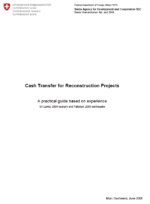
Cash Transfer for Reconstruction Projects, A practical guide based on experience
Gschwend Marc
Guideline, English, 23 pages
Summary
History does not repeat itself and complex events never happen twice in exactly the same way. So how can one be prepared for a possible next occurrence and how can one improve over time ? It may seem impossible at first sight. Fortunately one can often identify contexts and circumstances that share patterns sufficiently similar to allow one to make justified generalization about them. From then on, lessons can be learned regarding what strategies and tactics may be best adapted to achieve one's goals if faced again with a similar context. This is a basic learning process for any human being, and also for any organization. The above remark should help define the limited objective of this document : provide guidance and advice to those who may be involved in large scale Owner Driven Reconstruction programs following a natural disaster. This guidance is based not on theoretical assumptions but on two very distinct and yet very similar practical cases: · The post tsunami reconstruction program in Sri Lanka (2004-2007) · The post earthquake reconstruction program in Pakistan (2005-2008) In both these programs the reconstruction of private houses was owner-driven, based on conditional cash transfer methodology. If the preceding sentence sounds to you like jargon then maybe this document will not be of much help to you: it is really meant for people who are familiar with “the cash approach”.
Publication Year
2008
Topic
Construction | Construction Techniques | Reconstruction | Cash
